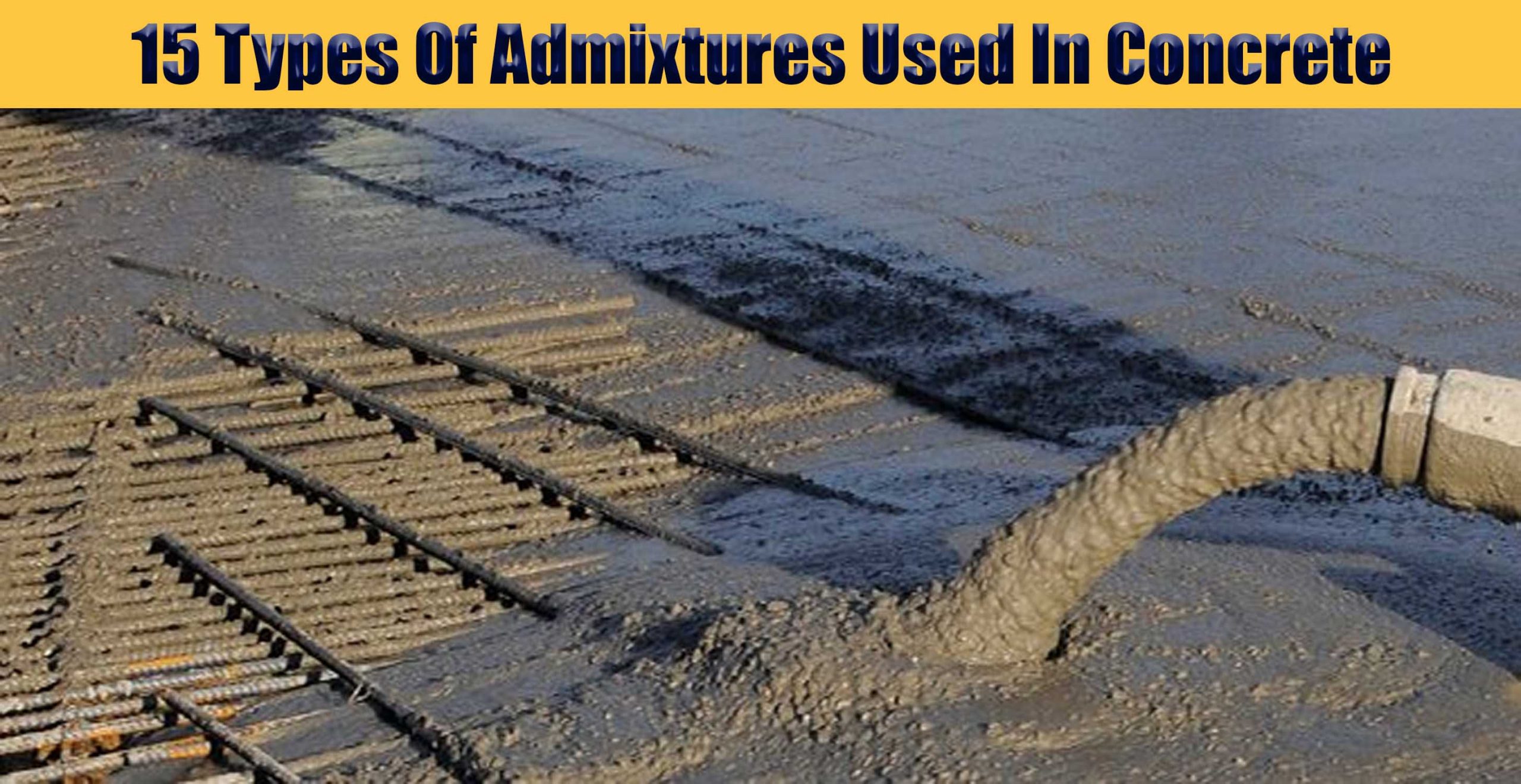Types of Concrete Admixtures
1- Water Reducing Admixtures
Water reducing admixtures, the name itself defines that they are used to minimize the water demand in a concrete mix. Workability is the important property of concrete which is improved with the addition of water but if the water is added more than required the strength and durability properties of concrete gets affected.
In addition, to increase in workability it also improves the strength of concrete, good bond between concrete and steel, prevents cracking, segregation, honeycombing, bleeding etc. Water reducing admixtures are also called as plasticizers and these are classified into three types namely plasticizers, mid-range plasticizers and superplasticizers. Normal plasticizer reduces the water demand by up to 10%, mid-range plasticizers reduce the water demand by up to 15% while superplasticizers reduce the water demand by up to 30%.
2- Retarding Admixtures
Retarding admixtures slow down the rate of hydration of cement in its initial stage and increase the initial setting time of concrete. These are also called as retarders and used especially in high-temperature zones where concrete will set quickly. The quick setting in some situations may lead to discontinuities in structure, the poor bond between the surfaces creates unnecessary voids in concrete etc. Retarders are useful to eliminate this type of problems. Commonly used retarding admixture is calcium sulphate or gypsum. Starch, cellulose products, common sugar, salts of acids are some other retarders. Most of the water-reducing admixtures are also acts as retarding admixtures and they are called as retarding plasticizers.
3- Accelerating Admixtures
Accelerating admixtures are used to reduce the initial setting time of concrete. They speed up the process of the initial stage of hardening of concrete hence they are also called as accelerators. These accelerators also improve the strength of concrete in its early stage by increasing the rate of hydration. Earlier hardening of concrete is useful in several situations such as early removal of formwork, less period of curing, emergency repair works, for constructions in low-temperature regions etc. Some of the accelerating admixtures are triethanolamine, calcium formate, silica fume, calcium chloride, finely divided silica gel etc. Calcium chloride is the cheap and commonly used accelerating admixture.
4- Air Entraining Concrete Admixture
Air entraining admixtures are one of the most important inventions in concrete technology. Their primary function is to increase the durability of concrete under freezing and thawing conditions. When added to the concrete mix, these admixtures will form millions of non-coalescing air bubbles throughout the mix and improves the properties of concrete. Air entrainment in concrete will also improve the workability of concrete, prevents segregation and bleeding, lower the unit weight and modulus of elasticity of concrete improves the chemical resistance of concrete and reduction of cement or sand or water content in concrete etc. Most used air entrainment admixtures are visual resin, darex, Teepol, Cheecol etc. These admixtures are actually made of Natural wood resins, alkali salts, animal and vegetable fats and oils etc.
5- Pozzolanic Admixtures
Pozzolanic admixtures are used to prepare dense concrete mix which is best suitable for water retaining structures like dams, reservoirs etc. They also reduce the heat of hydration and thermal shrinkage. Best pozzolanic materials in optimum quantity give the best results and prevent or reduces many risks such as alkali-aggregate reaction, leaching, sulfate attack etc. Pozzolanic materials used as admixtures are either natural or artificial. Naturally occurring Pozzolanic materials are the clay, shale, volcanic tuffs, pumicite, etc. and artificial pozzolans available are fly ash, silica fume, blast furnace slag, rice husk ash, surkhi etc.
6- Damp-proofing Admixtures
Damp-proofing or waterproofing admixtures are used to make the concrete structure impermeable against water and to prevent dampness on the concrete surface. In addition to the waterproof property, they also act as accelerators in the early stage of concrete hardening. Damp proofing admixtures are available in liquid form, powder form, paste form etc. The main constituents of these admixtures are aluminium sulfate, zinc sulfate aluminium chloride, calcium chloride, silicate of soda etc. which are chemically active pore fillers.
7- Gas forming Admixtures
Aluminium powder, activated carbon, hydrogen peroxide are generally used gas-forming chemical admixtures. When gas-forming admixtures are added, it reacts with hydroxide obtained by the hydration of cement and forms minute bubbles of hydrogen gas in the concrete. The range of formation of bubbles in concrete depends upon many factors such as the amount of admixture, the chemical composition of cement, temperature, fineness etc. The formed bubbles help the concrete to counteract the settlement and bleeding problems. Gas forming admixtures are also used to prepare lightweight concrete. For settlement and bleeding resistance purpose, a small quantity of gas-forming admixtures which are generally 0.5 to 2% by weight of cement is used. But for making lightweight concrete larger quantity generally, 100 grams per bag of cement is recommended.
8- Air detraining Admixtures
Air-detraining Admixtures are used to remove the excess air from the concrete voids. Sometimes, the aggregates may release the gas into concrete and air-entrained is more than required then this type of admixtures are useful. Some of the most used air-detraining admixtures are tributyl phosphate, silicones, water-insoluble alcohols etc.
9- Alkali Aggregate Expansion Preventing Admixtures
Alkali aggregate expansion in concrete is happened by the reaction of alkali of cement with the silica present in the aggregates. It forms a gel-like substance and causes volumetric expansion of concrete which may lead to cracking and disintegration. Use of pozzolanic admixtures will prevent the alkali-aggregate reaction and in some cases, air-entraining admixtures are also useful. Generally used admixtures to reduce the risk of alkali-aggregate reaction are aluminium powder and lithium salts.
10- Anti-washout Admixtures
Anti-washout admixtures are used in concrete especially for an underwater concrete structure. It protects the concrete mix from being washed out underwater pressure. It improves the cohesiveness of concrete. This type of admixtures is prepared from natural or synthetic rubbers, cellulose-based thickeners etc.
11- Grouting Admixtures
Grouting admixtures are added to grout materials to improve the grout properties according to the requirement of the grout. Sometimes, there is a need for quick set grout and sometimes there is a need for slow set grout to spread into deep cracks or fissures. Hence, different admixtures are used as grout admixtures based on the situation. Accelerators like calcium chloride, triethanolamine etc. are used as grout admixtures when the grout is to be set rapidly. Similarly retarders like mucic acid, gypsum etc. are used to slow down the setting time of grout. Gas forming admixtures like aluminium powder is added to grout material to counteract the settle of foundations.
12- Corrosion Preventing Admixtures
Corrosion of steel in reinforced concrete structure is general and it is severe when the structure is exposed to saline water, industrial fumes, chlorides etc. To prevent or to slow down the process of corrosion preventing admixtures are used. Some of the corrosion preventing admixtures used in reinforced concrete are sodium benzoate, sodium nitrate, sodium nitrite etc.
13- Bonding Admixtures
Bonding admixtures are used to create a bond between old and fresh concrete surfaces. In general, if fresh concrete is poured over a hardened concrete surface, there is a chance of failure of the fresh concrete surface due to a weak bond with the old surface. To make the bond stronger, bonding admixtures are added to cement or mortar grout which is applied on the concrete surface just before placing fresh concrete. This type of admixtures is used for pavement overlays, screed over roof provision, repair works etc. Bonding admixtures are water emulsions and they are made from natural rubber, synthetic rubbers, polymers like polyvinyl chloride, polyvinyl acetate etc.
14- Fungicidal, Germicidal, Insecticidal Admixtures
To prevent the growth of bacteria, germs, fungus on hardened concrete structures, it is recommended that the mix should have fungicidal, germicidal and insecticidal properties. This property can be developed by adding admixtures like polyhalogenated phenols, copper compounds and dieldrin emulsions etc.
15- Coloring Admixtures
Colouring admixtures are the pigments which produce colour in the finished concrete. The admixtures used to produce colour should not affect concrete strength. Generally, colouring admixtures are added to cement in a ball mill, then coloured cement can be obtained which can be used for making coloured concrete.
Click Here To See Properties Of Fresh Concrete With PDF File

